While every other week in 2014 incredible cattle sale prices were heard from auction yards or private sales, amidst jubilation everyone wondered if we had seen the peak. Will it hold? Where is the top? Will it spiral dangerously downward?
John Reigle and his son Andy consider these questions every single day. Outside the office windows are steel-pipe and sucker-rod pens containing 10,000 head of feeder cattle on the sloping hills near Madison, Nebraska.
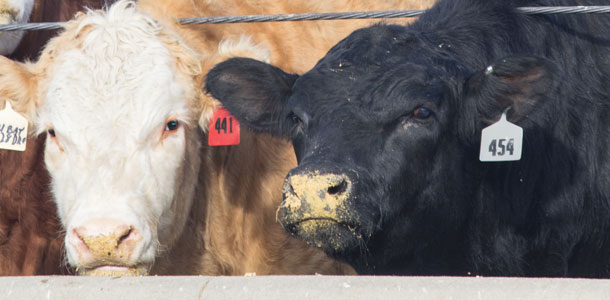
And none are custom-fed; Reigles own them all. Whenever the market price finally does drop, the impact will be substantial. “We’ll get caught. The only way not to get caught is to sell out right now,” says Reigle, and he doesn’t want to do that.
If he gets caught in a market dip, it won’t be the first time. John has been in the feedlot business since 1973. He’s weathered setback years.
Lower feed cost
Reigles shared their strategy for surviving fluctuating cattle markets over the long haul. “The biggest thing,” John says, “is to raise your own feed.” As the Reigles have acquired property through the years, they have expanded their crop base.
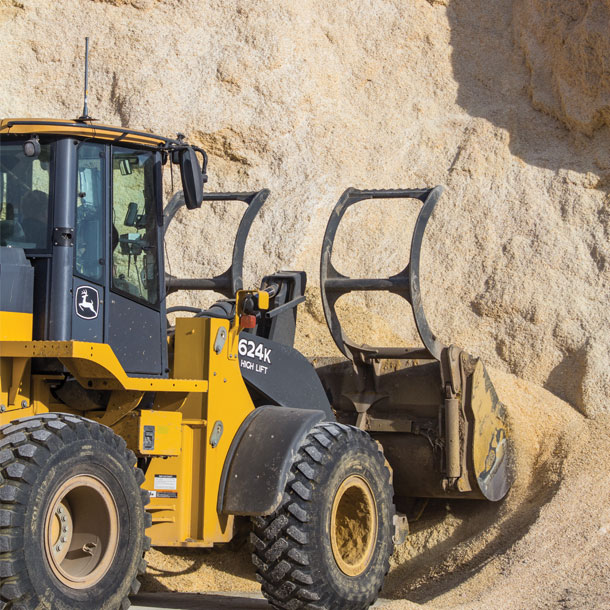 Today, they chop around 1,000 acres of silage and raise 425,000 bushels of high-moisture corn. They’ll buy another 425,000 bushels of corn from neighbors and supplement the ration with 30 to 40 percent distillers grains, which comes from an ethanol plant about 30 miles away.
Today, they chop around 1,000 acres of silage and raise 425,000 bushels of high-moisture corn. They’ll buy another 425,000 bushels of corn from neighbors and supplement the ration with 30 to 40 percent distillers grains, which comes from an ethanol plant about 30 miles away.
Andy is in charge of the farming operation. After several years of farming and raising his own cattle while working at the feedyard, Andy bought in to the outfit in July 2014, bringing with him a 10-year background of technology and precision farming.
Buy cheap, sell high
While permitted for 14,000 head and planning to build numbers to that level, to an outsider it seems it would be easier for Reigles to buy large cattle lots. Instead, they look for the bargains at auction yards.
“I still believe in buy cheap, sell high,” John says. “Some order buyers who buy for the feedlots will see a critter with no ears, no tail or one eye, and he doesn’t dare pick those up. There’s no reward for him to do that. But our cattle don’t have to be pretty.”
Reigle’s 87-year-old father, Kenneth Reigle, who started the three-generation feedlot, still travels with his wife, Dorothy, to the auction yards weekly to buy cattle.
“Kenny” and Dorothy know the value of a head of beef; they started farming about 1958 with the typical farm livestock – milk cows, sheep, chickens and hogs. They sold chickens to buy their first calf. By 1964, they had acquired about 300 head.
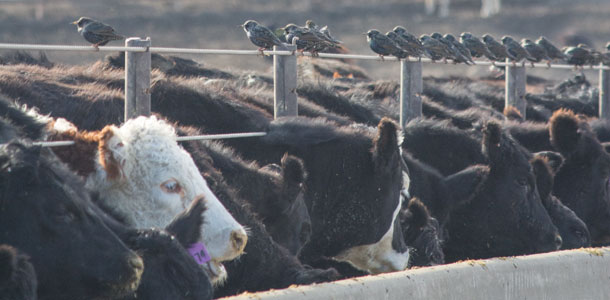 They’ve tried to add 400 to 500 head every year. John’s wife, Jeanne, says, “I remember moving onto the feedlot in 1982, and they were feeding around 2,500 head of cattle.
They’ve tried to add 400 to 500 head every year. John’s wife, Jeanne, says, “I remember moving onto the feedlot in 1982, and they were feeding around 2,500 head of cattle.
We knew some big – what I thought were big – cattle feeders from Ewing, Nebraska, that were feeding 5,000 head, and I remember thinking ‘Wow, wouldn’t it be something if someday we have 5,000 head?’” John and Jeanne raised their four children on the family feedlot with Jeanne helping sort, vaccinate or whatever needed to be done until she “graduated” to full-time participation in the office.
Apparently, the “not pretty” philosophy has worked. Average daily gain on the heifers has been 3 to 3.5 pounds, and cost of gain has fluctuated between low and high 70s, depending on weather.
However, with cattle numbers limited in the market, the Reigles are feeding the cattle longer, buying mostly 600- to 1,200-weights and feeding them to 1,200 to 1,500 pounds.
With packers not as willing to buy “heiferettes,” Reigle says they started buying younger, better cattle the past couple years. The bulk of the feeder cattle come from the South Dakota area.
Most of the fat cattle travel 100 miles to market. The fat cattle are normally 25 percent contracted, but during times of higher prices, such as those in late 2014, they had contracted about 40 percent to Tyson in Dakota City. About 80 percent grade choice.
Herd management
Another management principle that has served Reigles well is to become BQA-certified. When cattle are received, they’re sorted, sized, sexed and processed with vaccination protocols. Quarantine lasts a week before they are integrated into the regular feedlot.
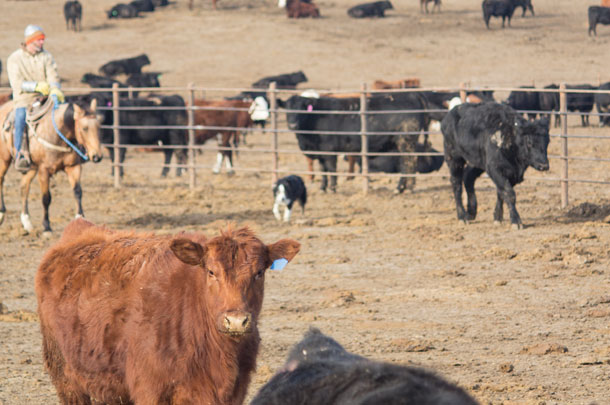 Two full-time pen riders monitor health issues and do most of the doctoring. A veterinarian assists with preg-checking twice a month.
Two full-time pen riders monitor health issues and do most of the doctoring. A veterinarian assists with preg-checking twice a month.
The Reigles use implants minimally. “Implants are good for a gain of 35 to 40 pounds per head, but they hurt the grade – you don’t get near as many prime,” John says. Tyson began using cameras to determine carcass market grade a few years ago, and John says an implant program, for him, is not as profitable.
Employee management
Another financial strategy the Reigles have used through the years is to keep the employee-to-cow ratio low. John said he read a long time ago that a feedlot (operating solely as a feedlot) should have no more than one employee per thousand head.
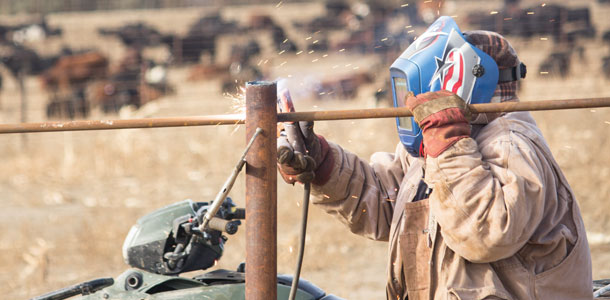
The Reigles have done a little better than that. With 10 employees (including John and Andy), they not only operate the feedlot but do all the farming as well.
Part of the reason that works, he says, is that they believe in going out and working with the cattle every day, not just sitting in the office.
“I always say that an employee will work just a little less than what I work, so hopefully if I’m working 110 percent, they’re working 90 percent,” John says. And to keep good employees, Reigles pay them “what they’re worth and then a little more.”
Andy’s wife, Alison, is a registered nurse who joined the Reigle Cattle Co. team in the summer of 2014. Alison concentrates on employee health and safety issues.
She handles preventative health for employees by arranging blood pressure checks, cholesterol checks, hearing tests, flu shots and working with local health institutions.
She also establishes protocols and monitors OSHA compliance records to the point of inviting OSHA representatives on the property to help them monitor noise levels with corn grinding equipment and make recommendations.
In addition, Alison writes a quarterly newsletter to send to employees, landowners and neighbors. Reigle Cattle Co. has a strong tradition of fostering good stewardship practices, transparency and neighborliness, and the newsletter is one outcome of that philosophy.
Purchasing discipline
The Reigles say beyond these principles, in preparation for lean times, they do what everybody else does: watch the purchases. “You’re forced to reduce your numbers to operate [in lean years], but you don’t go out and buy a new tractor,” Andy says.
John says he’s also been fortunate to buy land in the good years, so when prices dive he’ll have some collateral built. He operates on about 3,000 acres today and is building pens for herd expansion to meet his permit capacity of 14,000 head.
The record-setting cattle prices of 2014 were exciting and left everyone scrambling to capitalize on them. Undoubtedly, when prices climax and start to turn around, as they assuredly will, producers will be scrambling again to mitigate the damages.
In that event, the Reigles have a proven plan in place that has weathered many livestock financial cycles. Their commitment to produce their own feed, buy cheap and sell high, use sound herd management, maintain quality employees to match cattle numbers and exercise purchasing discipline has served them well. ![]()
PHOTOS
PHOTO 1: Andy Reigle and his wife, Alison, alongside his mother and father, Jean and John Reigle.
PHOTO 2: Reigles own all of their custom-fed feeder cattle on the Madison, Nebraska feedyard.
PHOTO 3: Reigles chop their own silage and raise their own corn, with 30 to 40 percent distillers grains from a nearby ethanol plant.
PHOTO 4: Cattle numbers have grown by 400 to 500 head each year at Reigle Cattle Co.
PHOTO 5: There are two full-time pen riders doing the doctoring at Reigle feedyard.
PHOTO 6: Reigles have 10 full-time employees operating the feedlot and working on the facilities. Photos courtesy of Lynn Jaynes.







